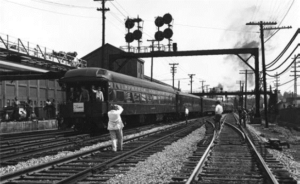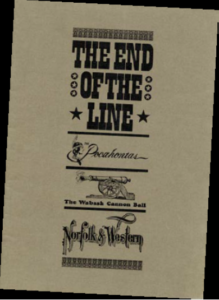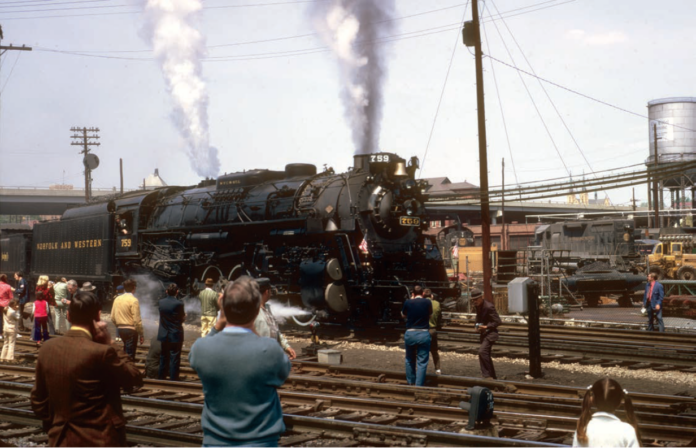On March 30, 1971 Norfolk and Western announced that last runs of trains 301-304, The Wabash Cannonball, 121-124, The City of Decatur and 3-4, The Pocahontas, would be on April 30. Discontinuance of intercity passenger service on the railway was a result of not including N&W routes by the National Railroad Passenger Corporation (Amtrak).
At 8:30 a.m., on Saturday, April 23, an unusual train pulled out of Vardo Yard at Hagerstown, Md. The southbound extra had 11 loads and 41 empties, plus two passenger type cars at the head end. N&W office car “Claytor Lake” and High Iron crew car “Conneaut.” On the point was former Nickel Plate Road No. 759. The big Berkshire was en route to Roanoke in order to power The Pocahontas between Roanoke and Norfolk on Saturday, May 1. Extra 759 had little trouble pulling 2100 tons until she got to Vaughn, 81 miles south of Hagerstown. Here she stalled as she attempted to pull the 55 cars over a short but steep grade. A 30 mph head wind contributed significantly to 759’s problem creating heavy drag on the empty hoppers.
The train was cut and the hill was doubled which resulted in a delay of over an hour. The mighty 2-8-4 encountered the same difficulty 1/2 mile below Luray on another hill. Within 200 feet of the top, the Berkshire slipped. The wind blew sand from the rails before the drivers could roll over it. Once again she attempted to surmount, the short 1.8% incline to no avail. Three times she tried to get over the hill. The empty hoppers on the rear were dropped on the main track for No. 95 to pick up later and the train ran into Shenandoah with 11 cars. After coaling and watering and with a new cab on the rear, the extra headed south for an uneventful run to Roanoke. Arrival was at 8:46 p.m.
The 759 was turned on Campbell Avenue Wye to be properly pointed for the run to Norfolk before being placed in the East End Shops complex for servicing and “modification.” The modifications consisted of lettering the tender “Norfolk and Western” and installation of the whistle from Class J No. 611.
 Friday, April 30 was the date for last runs of all intercity passenger runs on the Norfolk and Western. Numbers 17-18 made last trips between Lynchburg and Bristol. Train 3 as well as 17-18 all left Roanoke on time for the last time that Friday. Due to a pre-midnight departure from Cincinnati, eastbound No. 4 would not make her last run out of Roanoke until Sat., May 1. A crowd of over a thousand jammed the platforms at Roanoke long before No. 4 arrived at 11:04 a.m.
Friday, April 30 was the date for last runs of all intercity passenger runs on the Norfolk and Western. Numbers 17-18 made last trips between Lynchburg and Bristol. Train 3 as well as 17-18 all left Roanoke on time for the last time that Friday. Due to a pre-midnight departure from Cincinnati, eastbound No. 4 would not make her last run out of Roanoke until Sat., May 1. A crowd of over a thousand jammed the platforms at Roanoke long before No. 4 arrived at 11:04 a.m.
Just out of East End Shops and with restoration work completed was Class A No. 1218 on display on Track 2. The mammoth articulated would soon be on display in Roanoke’s Transportation Museum. Equipment from the Pocahontas which had arrived in Norfolk the day before had been deadheaded back to Roanoke during the night to provide room for the anticipated crowd.
This equipment along with baggage car 1286 was on Track 3. The baggage car was operated by Roanoke Chapter as a snack-souvenir concession selling soft drinks, sandwiches, candy, post cards, records, railroad caps and bandannas and other related items. Under the capable direction of Dave Helmer and Joe Austin, we were able to serve hundreds who would have not been able to have been served in the diner.
Scheduled railway passenger service in Roanoke became history as the most impressive train ever to run on the Norfolk and Western departed from Track 4 at 12:19 p.m. The crowd that lined the tracks saw a steam locomotive belching black bituminous smoke pull an 18-car train that included three domes and an open platform observation on the rear complete with a drumhead and oil marker lights.
For the first time in 12 years, the sound of a famous 600 whistle was heard in the Star City as the Pocahontas bid farewell to the headquarters city of the N&W and her people.
Over a thousand people rode the last Pocahontas. The 13 coaches were virtually full on leaving Roanoke. The passengers thinned out a little after Lynchburg, but the train was full again departing Petersburg. Two conductors collected tickets and checked passes. Three trainmen aided passengers on and off.
In the parlor car, “Lafayette”, local government officials and members of the press joined in the nostalgia. Among those present were National NRHS President E. Lewis Pardee, David P. Morgan and H. Reid. Diner-lounge 494 had been converted to a full diner seating 36. The line that formed in the aisle next to the kitchen reminded one of eating on the Pocahontas during World War II. Among others, N&W Executive Vice President R. B. Claytor enjoyed a last drink in the diner.
 All passengers were presented with an excellent commemorative souvenir booklet entitled “The End of The Line.” The booklet gives a complete account of passenger service on the Norfolk and Western from 1838 to the present. Included are reproductions of old timetables and pictures, many of which dated far back in the last century.
All passengers were presented with an excellent commemorative souvenir booklet entitled “The End of The Line.” The booklet gives a complete account of passenger service on the Norfolk and Western from 1838 to the present. Included are reproductions of old timetables and pictures, many of which dated far back in the last century.
Probably the most expedited coal and water stop of the diesel era was accomplished at Crewe that afternoon. Only 31 minutes were required to fill the tenders. Although 65 m.p.h. speeds were achieved between stations, the crowds that had gathered at every depot resulted in a few extra minutes delay at each stop. Even under the cover of darkness at Suffolk and South Norfolk people lined the tracks.
Over 2,500 were at the station in Norfolk to see a sight they would see no more. Intercity passenger service on the Norfolk and Western ended at 9:06 p.m., May 1, as the Pocahontas made her final station stop. What a grand way to mark the end of a prime example of an American Institution!
Re-printed with permission from “The Turntable Times.” Originally published on May 20 1971
– by Dorr Tucker


